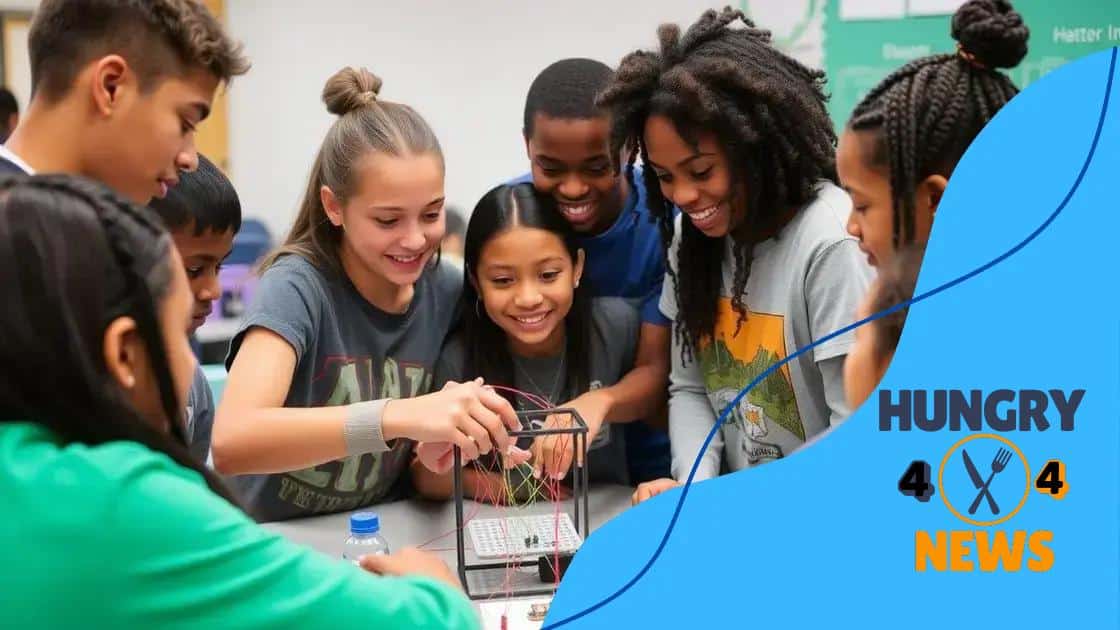STEM programs targeting underrepresented groups for success

STEM programs targeting underrepresented groups enhance inclusivity by fostering diversity through community partnerships, technology integration, and mentorship, paving the way for innovative leaders in science and technology.
STEM programs targeting underrepresented groups are vital for creating equal opportunities in education and careers. Ever wondered how they shape lives and communities? Let’s dive into their impact.
Understanding the barriers to participation
Understanding the barriers to participation in STEM programs targeting underrepresented groups is crucial for fostering inclusivity. Many students face challenges that prevent them from engaging fully in these fields. Factors like socioeconomic status, lack of access to resources, and inadequate role models can deter potential talent.
Common Barriers
Identifying these barriers helps to develop effective solutions. Here are a few common challenges:
- Financial constraints: Many students from underrepresented backgrounds may lack the funds needed for STEM courses or materials.
- Limited access to technology: Without appropriate tech resources, students can struggle to participate fully in STEM activities.
- Insufficient encouragement: Often, students may not receive the support or motivation needed to pursue STEM careers.
Moreover, cultural perceptions and stereotypes can influence a student’s confidence. Many underrepresented groups may feel that STEM is not for them due to societal beliefs. This mindset can hinder their willingness to engage with STEM programs.
Addressing the Barriers
Program design should focus on overcoming these obstacles. By tailoring initiatives to meet the needs of these students, organizations can create more equitable opportunities. Providing mentorship programs can drastically change perspectives and provide role models for young learners. Additionally, scholarships and grants specifically aimed at underrepresented groups can open doors that were previously closed due to financial hurdles.
Furthermore, fostering a community that celebrates diversity in STEM can encourage participation. When students see others like them succeed in these fields, it inspires hope and ambition.
Ultimately, addressing the barriers to participation in STEM programs targeting underrepresented groups is an ongoing effort. As awareness increases, so should the commitment to creating equitable educational environments.
Success stories from diverse students
Success stories from diverse students illustrate the transformative power of STEM programs targeting underrepresented groups. These narratives demonstrate how access to education can change lives and foster innovation.
Inspiring Achievements
Many students have overcome significant obstacles to excel in STEM fields. For example, Mia, a young woman from a low-income background, became the first in her family to go to college. With support from a local STEM program, she discovered her passion for computer science and is now pursuing a degree at a prestigious university.
Similarly, Amir, a high school student, participated in a robotics club through his school’s initiative. His dedication and hard work paid off when his team won a regional competition, placing him on a path to scholarships and mentorship opportunities.
- Building confidence: These stories highlight how STEM programs can build confidence among underrepresented students.
- Creating role models: As students succeed, they become role models for their peers, encouraging a new generation to pursue STEM careers.
- Fostering community: Success stories can unite communities, demonstrating the value of diversity in innovation.
Another inspiring example is Luis, who found a love for environmental science. His involvement in a mentorship program connected him with professionals in the field, allowing him to work on real-world projects. His story of determination emphasizes that with the right guidance, anything is possible.
Through these narratives, we see that diversity in STEM not only enriches the educational experience but also drives progress and innovation across the industry. Each success story adds to a larger narrative about what can be achieved when barriers are removed.
Key benefits of STEM education

The key benefits of STEM education are numerous and impactful, especially for underrepresented groups. These benefits extend beyond the classroom, shaping future careers and promoting innovation.
Enhancing Critical Thinking
One of the primary advantages of STEM education is its focus on critical thinking. Students learn to approach problems systematically and develop solutions based on analysis. This skill is valuable in all areas of life, from personal decisions to professional challenges.
Additionally, STEM education fosters creativity. Students are encouraged to experiment and think outside the box. Whether it’s designing a new app or building a robot, creative thinking is at the heart of STEM activities.
- Problem-solving skills: Students become adept at tackling complex problems through experimentation and teamwork.
- Collaboration: Many STEM projects require teamwork, helping students improve their collaboration skills.
- Career readiness: Hands-on experience prepares students for future jobs in a technology-driven economy.
Moreover, STEM education cultivates a passion for lifelong learning. Students who engage in STEM are often more curious and eager to explore new ideas. They learn to embrace challenges, which can lead to breakthroughs not just in their studies but in their future careers.
Building Future Leaders
Another benefit of a strong foundation in STEM is its role in developing future leaders. Students from diverse backgrounds bring unique perspectives that can drive innovation. By encouraging these students to pursue careers in STEM, we enable them to lead in their communities and industries.
Furthermore, STEM education contributes to addressing societal challenges. With increased participation from underrepresented groups, future innovations will reflect a broader range of experiences and needs. This diversity can lead to more inclusive solutions and advancements that benefit everyone.
Ultimately, investing in STEM education is investing in a brighter, more equitable future for all. As we support diverse learners, we pave the way for a generation that is not only skilled in technology but also equipped to lead and innovate in various fields.
Effective strategies for outreach
Effective strategies for outreach play a crucial role in encouraging participation in STEM programs targeting underrepresented groups. These strategies help engage students, parents, and communities, creating pathways to opportunities.
Building Community Partnerships
One successful approach is to build strong partnerships with local organizations. Collaborating with community centers, schools, and businesses enriches outreach efforts. These partnerships can help promote STEM activities and create a supportive network for students.
- Workshops and Events: Hosting free workshops or events can attract interest. These gatherings allow students to experience STEM hands-on and ignite their passion.
- Mentorship Programs: Connecting students with mentors from diverse backgrounds can provide guidance and support, making them feel more included.
- Family Engagement: Involving families in STEM-related activities ensures support at home. When families participate, students are more likely to pursue STEM education.
Additionally, schools can implement after-school programs that focus on engaging hands-on learning. These programs should emphasize collaboration and creativity, allowing students to explore STEM concepts in a fun environment.
Utilizing Technology for Outreach
Another effective strategy is leveraging technology to reach a wider audience. Online platforms can facilitate greater engagement with students who may not have access to STEM programs locally. Virtual workshops, webinars, and online resources make programs accessible to those who face transportation or logistical challenges.
Social media is also a powerful tool for outreach. By showcasing success stories and program activities, organizations can inspire interest among potential participants. Engaging content can reach diverse audiences and highlight the importance of inclusivity in STEM.
Ultimately, implementing these effective outreach strategies helps to create a more inclusive environment in STEM education. By targeting underrepresented groups, we can inspire and empower the next generation of innovators and leaders.
Future trends in STEM inclusivity
Future trends in STEM inclusivity are promising, aiming to broaden participation and ensure that diverse voices contribute to science and technology. As society progresses, several key trends are emerging that will shape the landscape of STEM education.
Emphasis on Diversity and Representation
One of the most significant trends is the increased emphasis on diversity and representation within STEM fields. Organizations are recognizing that a diverse workforce leads to more innovative solutions. Initiatives promoting women, people of color, and other underrepresented groups are gaining momentum.
- Recruitment Efforts: Companies and institutions are actively recruiting diverse talent through outreach and scholarships.
- Support Systems: Providing mentoring and support systems can empower underrepresented students to pursue STEM careers.
- Inclusive Curriculum: Educational programs are adapting to include contributions from diverse cultures in science and technology.
Meeting these goals requires a commitment from both educational institutions and employers to create environments where all students feel valued and included.
Integrating Technology in Learning
Another trend is the integration of technology in STEM education. Virtual reality, artificial intelligence, and online learning platforms are revolutionizing how STEM subjects are taught. These tools can make learning more accessible, allowing students from all backgrounds to engage with complex concepts.
Furthermore, gamification in education is becoming popular. It helps make learning enjoyable and interactive, motivating students to explore STEM fields without the intimidation often associated with traditional teaching methods.
More importantly, partnerships between schools and tech companies can provide students with hands-on experience. Programs that connect students with real-world applications of STEM fields can inspire them to pursue these careers passionately.
As we look to the future, the focus on STEM inclusivity is expected to grow. With continued dedication, the educational landscape will evolve, paving the way for a new generation that values diversity and innovation in STEM.
FAQ – Frequently Asked Questions about STEM Programs and Inclusivity
What are STEM programs targeting underrepresented groups?
STEM programs targeting underrepresented groups are initiatives designed to engage, support, and uplift students from diverse backgrounds in science, technology, engineering, and mathematics.
Why is diversity important in STEM fields?
Diversity in STEM fields fosters innovation, creativity, and problem-solving by bringing together a range of perspectives and experiences to address complex challenges.
How can I get involved in promoting STEM inclusivity?
You can get involved by volunteering with local organizations, mentoring students, participating in outreach events, and advocating for diverse representation in STEM education.
What future trends are shaping STEM inclusivity?
Future trends include a greater focus on diverse recruitment, integrating technology in learning environments, and a commitment to inclusive curricula that reflect various contributions in science and technology.





